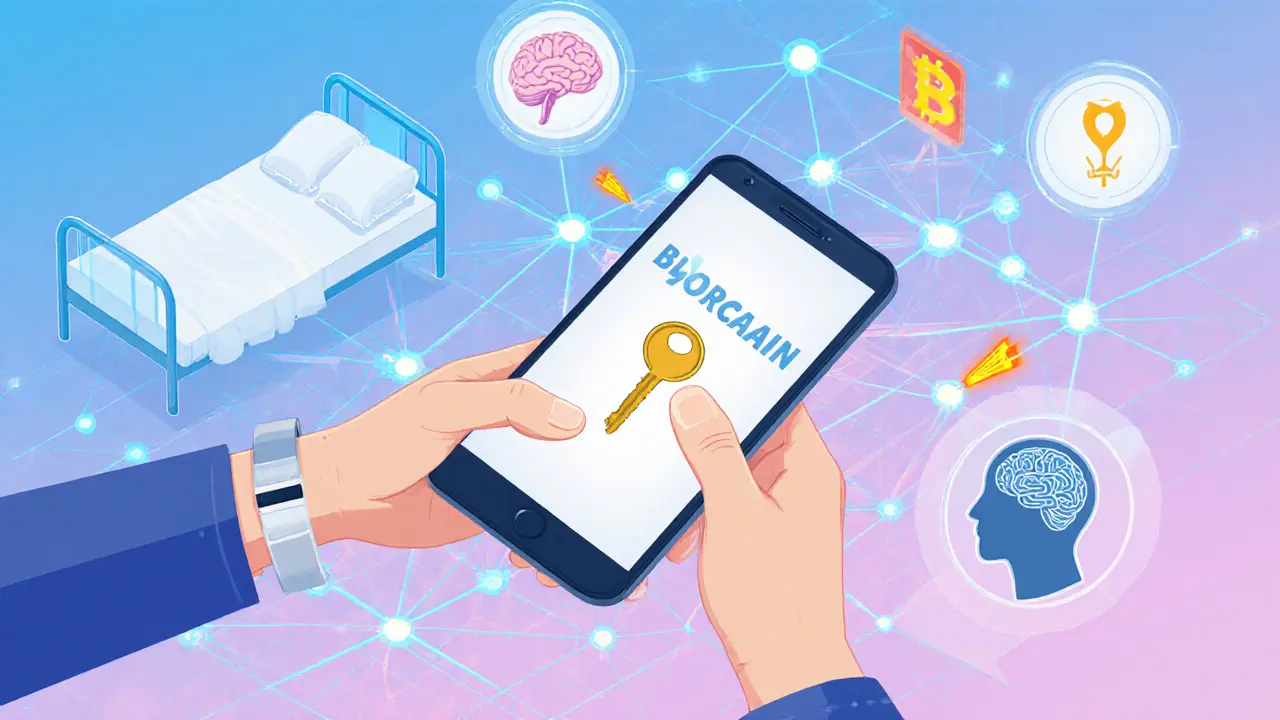Blockchain Healthcare Data Security Cost Calculator
Calculate Your Potential Savings
Estimate implementation costs and annual savings for blockchain healthcare data security based on your organization size and current data management costs.
Estimated Results
Enter your organization details above to see your estimated savings.
When it comes to protecting medical records, Blockchain Healthcare Data Security is a decentralized approach that uses cryptographic ledgers to store and share patient information securely. Imagine a system where every copy of a health file is locked in a puzzle only you can solve - that’s the promise of blockchain for health data.
What Exactly Is Blockchain Healthcare Data Security?
At its core, this technology combines three ideas: a permissioned blockchain network, encrypted fragments of patient data, and smart contracts that act like digital gate‑keepers. The network isn’t open to anyone; only vetted hospitals, labs, insurers, and the patients themselves can join. Each piece of a medical record is split, encrypted, and scattered across multiple nodes. No single node holds the whole picture, so a hacker would need to crack dozens of keys at once to make sense of anything.
Permissioned Blockchain limits participation to verified entities, enforcing strict identity checks and continuous authentication while still keeping the ledger immutable. Smart Contracts are self‑executing code snippets that grant or deny access based on pre‑agreed rules, so a doctor can view a lab result only after the patient gives the green light.
How Does It Actually Work?
- Data Capture - An EHR system creates a new record (e.g., a radiology report).
- Fragmentation - The record is broken into encrypted shards.
- Distribution - Each shard is sent to a different node in the blockchain network.
- Hashing - A cryptographic hash is generated for every shard, creating an immutable fingerprint.
- Smart Contract Creation - A contract stores the hash, the required permissions, and the patient’s public key.
- Access Request - A provider submits a request; the smart contract checks the patient’s consent and, if approved, releases the decryption key.
- Reassembly - The provider reassembles the shards, decrypts the data, and views the full record.
All of these steps happen in seconds, and every action is recorded on the ledger for full auditability.
Key Benefits Over Traditional Centralized Systems
- Immutability: Once a shard is written, it can’t be altered without breaking the hash chain.
- Patient‑Centred Control: Users keep the private keys that unlock their data, meaning they decide who sees what and when.
- Reduced Breach Impact: Stealing one node gives attackers an incomplete, useless fragment.
- Automation via Smart Contracts: Consent, HIPAA compliance checks, and claim validations run without human bottlenecks.
- Cost Savings: Industry studies estimate up to $100billion saved annually by cutting manual reconciliation and fraud.

Challenges and Real‑World Limitations
Nothing is perfect. The biggest hurdles are upfront costs, technical complexity, and the learning curve for staff.
- Implementation Cost can run into millions for large hospital systems due to hardware, consultancy, and training expenses.
- Scalability: Current blockchain throughput (often under 1,000 transactions per second) makes high‑frequency monitoring data harder to handle.
- Key Management Fatigue: Patients may forget or lose their private keys, requiring robust recovery mechanisms.
- Regulatory Alignment: Solutions must still satisfy HIPAA in the U.S. and GDPR in Europe, which adds compliance testing overhead.
Step‑by‑Step Implementation Roadmap
- Assess Current Infrastructure: Map existing EHRs, identify integration points, and catalog compliance requirements.
- Choose a Platform: Vendors like MedChain offer permissioned networks tailored for hospitals or MedRec focus on patient‑controlled consent flows.
- Build a Cross‑Functional Team: Include IT, clinical staff, compliance officers, and a blockchain specialist.
- Develop Smart Contracts: Define consent logic, audit triggers, and claim‑processing rules.
- Pilot with a Single Department: Start with radiology or pharmacy to limit scope and collect performance data.
- Train End‑Users: Run hands‑on workshops for clinicians and educational sessions for patients on key management.
- Scale Gradually: Add more specialties, then connect partner institutions for research data sharing.
- Monitor & Optimize: Track latency, cost per transaction, and breach‑attempt metrics; tweak contracts as needed.
Market Landscape - What’s Happening Today?
In 2025 the global market sits at roughly $4.2billion and is projected to hit $5.7billion by 2026, riding a 39% CAGR. About 40% of hospitals have either started or are planning a blockchain project, led mostly by large academic medical centers in North America and Europe.
Key players include established IT giants expanding into blockchain (e.g., IBM Blockchain for Health) and pure‑play startups like MedChain, MedRec, and HealthLedger. Funding rounds have surged, with venture capital pouring over $300million into health‑focused blockchain ventures in the past two years.
| Aspect | Centralized Systems | Blockchain Approach |
|---|---|---|
| Data Ownership | Provider‑centric | Patient‑centric via key control |
| Single Point of Failure | Yes - one server breach can expose all records | No - data spread across many nodes |
| Audit Trail | Manual logs, prone to tampering | Immutable ledger with timestamped entries |
| Interoperability | Often siloed, hard to share | Standardized smart contracts enable seamless sharing |
| Scalability | High transaction throughput | Limited by current blockchain performance |

Future Trends - Where Is This Heading?
- AI Integration: Smart contracts will trigger AI‑driven diagnostic alerts when new lab data lands on the ledger.
- IoT Med Devices: Wearable sensors can write encrypted readings directly to the blockchain, creating a tamper‑proof health timeline.
- Regulatory‑Ready Frameworks: New standards from the ONC and European Health Data Space are expected to codify blockchain‑compatible consent models.
- Consumer‑Friendly Apps: Mobile wallets will let patients manage their health keys with a few taps, lowering the barrier to adoption.
Key Takeaways
- Blockchain turns health records into immutable, patient‑controlled assets.
- Smart contracts automate consent, compliance, and claim processing.
- Implementation demands significant upfront investment and specialized talent.
- Current market momentum suggests wide adoption among large health systems within the next 3‑5 years.
- Future convergence with AI and IoT will deepen the value proposition.
Frequently Asked Questions
Is blockchain really needed for health records?
Yes, because it eliminates single points of failure, provides an auditable trail, and gives patients direct control over who sees their data.
Can existing EHR systems be integrated?
Most modern EHRs expose APIs, so a blockchain layer can be added as a middleware that encrypts and shards data before it reaches the ledger.
What happens if a patient loses their private key?
Solutions include social‑recovery mechanisms, hardware recovery tokens, or custodial services that can re‑issue a new key after identity verification.
Does blockchain comply with HIPAA and GDPR?
Permissioned networks can be designed to meet both HIPAA’s security rule and GDPR’s data‑subject rights, especially when encryption and access controls are enforced at the contract level.
How long does a typical implementation take?
Full‑scale deployments usually run 12‑24months, with a pilot phase of 3‑6months to iron out integration and training issues.


1 Responses
Blockchain healthcare is just another overpriced vanity project for tech evangelists to pat themselves on the back.